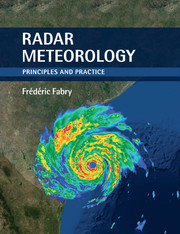Book contents
- Frontmatter
- Dedication
- Contents
- Preface
- Notation
- 1 Meteorology and radar
- 2 Fundamentals of weather radar measurements
- 3 Radar reflectivity and products
- 4 Reflectivity patterns
- 5 Doppler velocity information
- 6 The added value of dual polarization
- 7 Convective storm surveillance
- 8 Monitoring widespread systems
- 9 Radar estimation of precipitation
- 10 Nowcasting
- 11 Additional radar measurements and retrievals
- 12 Cloud and spaceborne radars
- 13 What does radar really measure?
- Appendix A Mathematics and statistics of radar meteorology
- References
- Index
8 - Monitoring widespread systems
Published online by Cambridge University Press: 05 June 2015
- Frontmatter
- Dedication
- Contents
- Preface
- Notation
- 1 Meteorology and radar
- 2 Fundamentals of weather radar measurements
- 3 Radar reflectivity and products
- 4 Reflectivity patterns
- 5 Doppler velocity information
- 6 The added value of dual polarization
- 7 Convective storm surveillance
- 8 Monitoring widespread systems
- 9 Radar estimation of precipitation
- 10 Nowcasting
- 11 Additional radar measurements and retrievals
- 12 Cloud and spaceborne radars
- 13 What does radar really measure?
- Appendix A Mathematics and statistics of radar meteorology
- References
- Index
Summary
Radar, widespread systems, and threat forecasting
8.1.1 Time to re flect
Because radar has revolutionized the way convective storms can be monitored, it is primarily thought of as an instrument to be used for observing smaller, more rapidly evolving systems (Fig. 8.1). An undesirable consequence of this mental association between convective weather and radar is that when larger, or slowly evolving widespread systems are on the forecast menu, we often stop looking at the radar data and primarily rely on other sources of information.
Admittedly, there are at least two good reasons for downplaying the role of radar in widespread systems: (1) there are many additional tools to analyze widespread systems, from satellite imagery to surface and upper-air measurements, in addition to model-based prognosis; and (2) individual radar coverage is small compared with most widespread systems (e.g., Figs. 1.4 and 8.1), making it inappropriate for a complete assessment of the weather situation.
However, since widespread systems can also be disruptive, any instrument that can help assess the possible weather threats should be used. Moreover, radars being networked, it is now possible to get radar information over wider scales and to easily access data from radars outside of one's forecast region. Finally, forecasters have a luxury that they do not have when forecasting convective systems: time. Instead of just reacting to a fast-evolving situation, they can afford to reflect a few minutes and consider the more subtle yet rich information provided by radar under these circumstances.
As a result, this extra time can allow us to do more than just warn for an existing threat. Radar is most useful in widespread systems when it provides information that shows important discrepancies between what is expected to be observed given the current forecast and what is actually happening, and then provides additional clues on how to modify the forecast. Radar hence becomes less of a primary detection tool as it was in convection, but instead assumes a key role to help adjust forecasts, particularly in the 0- to 12-h time frame.
- Type
- Chapter
- Information
- Radar MeteorologyPrinciples and Practice, pp. 133 - 147Publisher: Cambridge University PressPrint publication year: 2015



